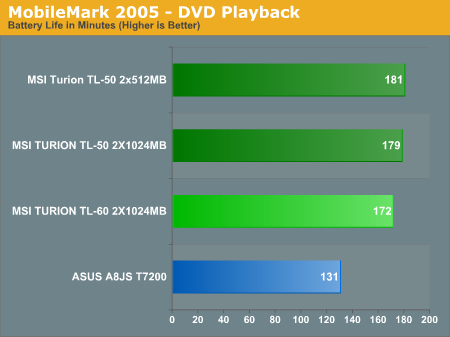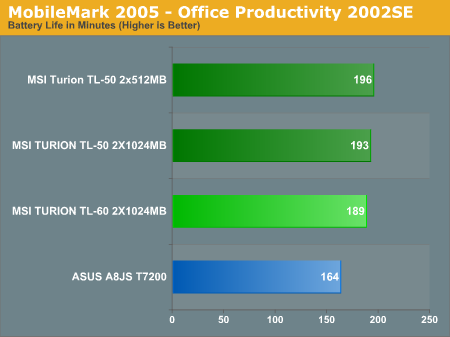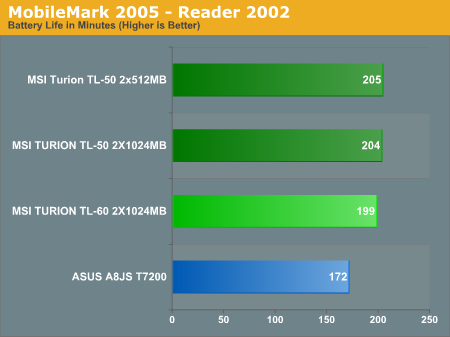MSI Megabook S271: a Look at AMD's Turion X2
by Jarred Walton on October 16, 2006 12:05 AM EST- Posted in
- Laptops
Battery Life
So far, we've talked a lot about performance, but one of the major reasons for getting a laptop is mobility. It's difficult to be truly mobile if you find your battery is constantly going dead, requiring you to find a power outlet so you can plug in and recharge. Thus, battery life becomes an important performance metric for any laptop review. It's also worth mentioning that the smaller size of the MSI notebook is going to appeal to some people that are after a truly thin and light notebook, while others will prefer to have a slightly larger display and keyboard at the cost of a bit more weight. Larger displays also draw more power, and of course the various other components play a role in battery life.
All this is a way of saying that we're comparing battery life and power between two very different laptops, with the only similarity being the amount of memory and processor clock speed. A smaller Core 2 Duo notebook with integrated graphics would almost certainly come with longer battery life. Still, given that both these laptops have the same 4800 mAHr battery size, we can at least see how the two systems compare.




With the exception of office productivity performance, the smaller, slower MSI laptop comes out at the top of our mobility benchmarks. The ASUS notebook may be 37% faster in productivity tasks, but the MSI offers 15% more battery life. When the system is basically idle, which is represented by the Reader benchmark, the MSI system continues to have 15% more battery life. Once we get to DVD playback, things become more interesting, as the MSI offers over 30% more battery life, with just over 2 hours and 40 minutes of playback time. That should be enough to get you through all but the longest DVDs, as well as most continental US flights. Given that the displays are active throughout testing in all of the battery benchmarks, we're not exactly sure why the DVD playback shows such a large discrepancy. It could be that the optical drive on the MSI notebook is simply better at conserving power, or else the MSI system is more efficient when it comes to handling MPEG-2 decoding and video output. Most likely, DVD playback is causing the GeForce Go 7700 GPU in the ASUS system to increase its power use.
If you want longer battery life, you basically end up with a few options. The first option is to simply get a larger battery, which may or may not be possible depending on what notebook you have. Both of these laptops include 4800 mAHr batteries, whereas larger laptops can often be configured with 8000 mAHr or larger batteries, so the second option is to look into getting a larger laptop that comes with a larger battery. The Dell E1705 with X1400 graphics is a good example of this option, and you can see the battery life we measured in our review. Of course, larger batteries also mean more weight to carry around, not to mention the weight of the larger laptops. Depending on the laptop model, versions that use IGP instead of discrete graphics will often have longer battery life (as seen in this comparison with the ASUS). A final option is to simply purchase a spare battery (or batteries) so that you can swap batteries when one runs low. This also adds to the weight you carry around, but other than the periodic delay to swap batteries, your total battery life is only limited by how much you're willing to spend and how much you want to carry.
So far, we've talked a lot about performance, but one of the major reasons for getting a laptop is mobility. It's difficult to be truly mobile if you find your battery is constantly going dead, requiring you to find a power outlet so you can plug in and recharge. Thus, battery life becomes an important performance metric for any laptop review. It's also worth mentioning that the smaller size of the MSI notebook is going to appeal to some people that are after a truly thin and light notebook, while others will prefer to have a slightly larger display and keyboard at the cost of a bit more weight. Larger displays also draw more power, and of course the various other components play a role in battery life.
All this is a way of saying that we're comparing battery life and power between two very different laptops, with the only similarity being the amount of memory and processor clock speed. A smaller Core 2 Duo notebook with integrated graphics would almost certainly come with longer battery life. Still, given that both these laptops have the same 4800 mAHr battery size, we can at least see how the two systems compare.




With the exception of office productivity performance, the smaller, slower MSI laptop comes out at the top of our mobility benchmarks. The ASUS notebook may be 37% faster in productivity tasks, but the MSI offers 15% more battery life. When the system is basically idle, which is represented by the Reader benchmark, the MSI system continues to have 15% more battery life. Once we get to DVD playback, things become more interesting, as the MSI offers over 30% more battery life, with just over 2 hours and 40 minutes of playback time. That should be enough to get you through all but the longest DVDs, as well as most continental US flights. Given that the displays are active throughout testing in all of the battery benchmarks, we're not exactly sure why the DVD playback shows such a large discrepancy. It could be that the optical drive on the MSI notebook is simply better at conserving power, or else the MSI system is more efficient when it comes to handling MPEG-2 decoding and video output. Most likely, DVD playback is causing the GeForce Go 7700 GPU in the ASUS system to increase its power use.
If you want longer battery life, you basically end up with a few options. The first option is to simply get a larger battery, which may or may not be possible depending on what notebook you have. Both of these laptops include 4800 mAHr batteries, whereas larger laptops can often be configured with 8000 mAHr or larger batteries, so the second option is to look into getting a larger laptop that comes with a larger battery. The Dell E1705 with X1400 graphics is a good example of this option, and you can see the battery life we measured in our review. Of course, larger batteries also mean more weight to carry around, not to mention the weight of the larger laptops. Depending on the laptop model, versions that use IGP instead of discrete graphics will often have longer battery life (as seen in this comparison with the ASUS). A final option is to simply purchase a spare battery (or batteries) so that you can swap batteries when one runs low. This also adds to the weight you carry around, but other than the periodic delay to swap batteries, your total battery life is only limited by how much you're willing to spend and how much you want to carry.










31 Comments
View All Comments
ShapeGSX - Monday, October 16, 2006 - link
The Core 2 Duo mobile processors DO support 64 bit instructions!Core Duo does not.
randomas - Tuesday, October 17, 2006 - link
Doh! I guess I should have checked then, but all the more reason to see them both pull their weight with a real OS!Wesleyrpg - Monday, October 16, 2006 - link
hey all,im eager to see a review of the a8js, thats the laptop that i got my eye on at the moment, if asus play their cards right, the a8js could become one VERY popular laptop.
Any idea on availability though on the A8JS?
piesquared - Monday, October 16, 2006 - link
Good review, but which system was being reviewed, the Asus C2D or the MSI X2?duploxxx - Monday, October 16, 2006 - link
Nice comment, whenever it fits there results, they will publish it.. (does remember me of the time you would test 2P wood-opty in windows, but probably the result was not as expected of your sponsor). Also the memory issues do question your results......the core2duo is for sure the better performing one. Few months ago the X2 versus coreduo was a tight battle, but we all saw the core2duo outperforming the coreduo with glance, so the same thing happens with turion. Intel made his design for laptop and changed it up to desktop and server, AMD did it the other way around.... so for a 3year old design I think it was rather good against all those updating Mobile en core technologies from Intel.
Now from an other perspective. Most of the laptops are supplied with Intel internal graphics. How Will this perform against the ATi Graphics? that would be an interesting review.......
JarredWalton - Monday, October 16, 2006 - link
ATI Xpress 1100 is about twice as fast as GMA950, plus it has full DX9 support (though not SM3.0). Problem is, it's pathetically slow still. I mean, what can you want that the Xpress 1100 can provide but the GMA950 can't? 20 FPS at minimum quality in HL2? If you want 3D performance, I'd say the 7700 in the A8JS is a good starting point. X1400 and GeForce 7400 are both substantially faster than Xpress 1100, buth still pretty sluggish for actual 3D work. X1400 is still okay for video playback and older games (as is 7400), but you can get 7600/7700 for about the same cost I think.JarredWalton - Monday, October 16, 2006 - link
MSI today, ASUS later this week. It's probably already clear which one we preferred, but there's more to say about the ASUS and putting out a 14000 word article seemed like overload.piesquared - Monday, October 16, 2006 - link
Yes, i know, and sorry for the sarcastic question. I guess i'm just wondering why so much content on the Asus solution, when as you say there will be a seperate review later this week. My overall picture of that article was that AMD's solution was a steaming pile of mess not really suitable for anyone. At least that's the impression i(and probably most visitors that read or will read it, so i guess it was successful that way) got, regardless of any conlusion throwing it a bone here and there. What i can't understand is why MSI would even offer up such an abomination for review!! ;)BTW, i did think it was a very good article, aside from the above mentioned slant that seem to ooze from it..
JarredWalton - Monday, October 16, 2006 - link
It's basically a case of getting an okay system, but we would say there are better options out there. If the MSI is cheaper, faster, has more battery life, or some other benefit than other competing laptops, great. It's basically at best equal to other ultraportable options.The ASUS W5F with Core Duo is about as fast (with "slower" integrated graphics, though it doesn't matter much), but it costs more, so there you could say the S271 is "better". Unfortunately, there aren't many faster Turion X2 notebooks around, other than the MSI MS-171772 mentioned in the conclusion.
If all you're after is ultraportables, the MS-1058/S271 is about all I see for Turion X2. It does tend to be about $100-$200 cheaper than any Core 2 equipped ultraportables, or about the same cost as Core Duo equipped ultraportables. In that market, it has a place. I'm not a huge fan of ultraportables, but some people are. I'd personally rather carry an extra 2 pounds and get a 14" (or larger) display.
aidanjm - Monday, October 16, 2006 - link
you rip apart a closed system not designed to be opened up by the consumer, fiddle around inside, then complain when things don't work? even the complaints on memeory compatability seem lame.